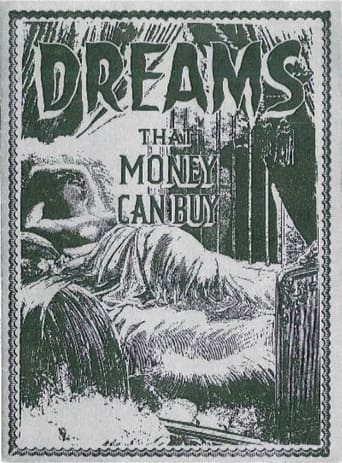



Please don't spend money on this.
The thing I enjoyed most about the film is the fact that it doesn't shy away from being a super-sized-cliche;
View MoreThe tone of this movie is interesting -- the stakes are both dramatic and high, but it's balanced with a lot of fun, tongue and cheek dialogue.
View MoreBlistering performances.
This quirky surrealist film follows the adventures of a dream seller as he supplies dreams to his mixed clientele.The dreams were created by various artists, and the quality and style varies. Max Ernst comes the closest to creating something with a real feel for dream logic involving the saving of a woman, although it was a little slow. Richter also comes close with the final, blue-faced sequence. Marcel Duchamp and Alexander Caldwell, on the other hand, both contribute simple movement pieces, although Caldwell also offers a somewhat interesting stop-motion circus scene.The most interesting piece is by the one artist I've never heard of, Fernand Leger, a clever musical piece involving mannequins.Avant-garde works being what they are, you probably wouldn't know this was made in 1947 if you weren't told, as filmmakers today will go for a retro style. It's a mixed bag, but I'd say it's worth watching if you're interested in surrealism.
View MoreThis is a great film for fans of the surrealist and dadaist movements and offers a lot of great moments by a wide range of talented artists, but it falls just short of the glory of what it could have been. The running time pushes the boundaries of what many of us, even fans of surrealism, can handle.The film is a series of vignettes joined by a central story but on a whole it's not quite cohesive, and it's not even in-cohesive in an interesting way. All in all with the names involved, you just go in expecting more. It's a good little gem of experimental cinema but I was frankly wanting a little more...
View MoreThe Avant Garde movement is not one that I follow, or know too much about, though I had seen some work by Duchamp at an exhibition in London once. However, I'll try very nearly anything and so when Dreams that Money Can Buy came up on Film 4 very late at night, I had to give it a go.I could not find a separate listing as to which director did which part on the IMDb, but I have to say that I only really enjoyed two segments - Duchamp's 'Discs' and the last one, 'Narcissus' by Hans Richter. I really liked the geometric patterns and shadows of the masks and things in Duchamp's and the overall operatic, Gothic feel of Richter's, which had some great visual flair.I persevered with the others and whilst I could see definite skill and talent in many pieces, they weren't really "me". My score is probably nearer the 5.5 mark than 6, but I'm rounding up slightly. Apologies to all who love this work, but with an alternative and rare film such as this, it's always going to divide opinion - and I did give it a go!
View MoreHans Richter, original Dada member and an important figure in keeping alive the memory of the 20th century's greatest art movement (his memoirs 'Dada: Art and Anti-Art' is one of the most touching non-fiction books I've ever read), was also a pretty good filmmaker. He started making shorts in the '20s, much in the vein of the avant-garde cinema that Buñuel, Cocteau, and Man Ray were doing at the time. In 1947 he got together with a few Dada friends - Ray, Duchamp, Max Ernst, etc. - and made Dreams That Money Can Buy, one of the most beautiful avant-garde movies ever made.Joe, a down-on-his-luck everyman, finds out he has the ability to create dreams for people. Because we live in dull, colorless world, he has no trouble finding customers in need of dreams. This is really a frame narrative for the heart of the movie: the seven dreams composed by the artists. Each one is inventive and unpredictable; some have people, other wire toys; and some are just abstract images without nexus.Dreams That Money Can Buy is a pretty complete movie: it has musical, comedy, film noir, and drama. It also has what seems like the beginnings of stop-motion animation, which Czech filmmakers like Jan Svankmajer and Jirí Trnka would later perfect. The voice-over is detached and sarcastic, making fun of everything happening, much like the narrators of writers Milan Kundera or José Saramago.Shot over sixty years ago, Richter's movie still looks modern and innovative. It fills the viewer's head with ideas and bubbles with potential that most cinema seldom explores. With world cinema going through a dull phase, rediscovering this movie could only help directors and screenwriters leave their lethargy and attempt something new.
View More